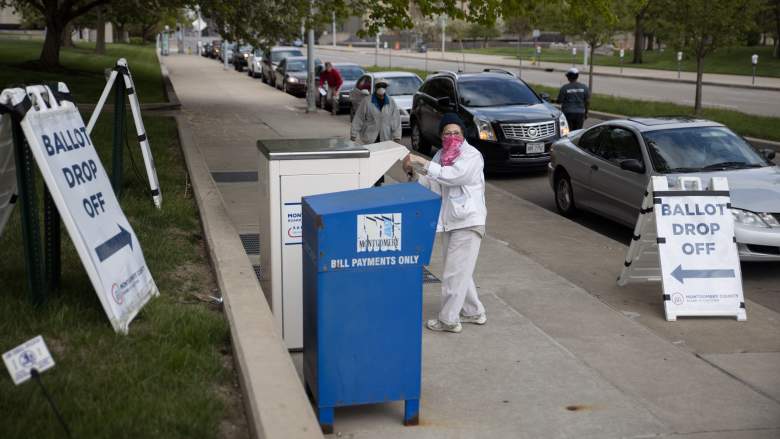
Getty Ohio voters line up in their cars to drop off their ballots at the Board of Elections in Dayton, Ohio on April 28, 2020.
As social distancing guidelines remain in effect and a COVID-19 vaccine remains distant, universal vote-by-mail has become an increasingly appealing means of conducting the 2020 election. While many Americans are familiar with absentee ballots, universal vote-by-mail only exists in a handful of states, prompting confusion about the process and its advantages and disadvantages.
Here’s what you need to know about universal vote-by-mail:
5 States In The Union Currently Conduct All Elections Entirely By Mail
Oregon became the first state to implement universal vote-by-mail in 1998. Since then, Colorado, Utah, Washington, and Hawaii have passed similar measures. These five states now conduct all of their elections entirely by mail. In California, Nebraska, and North Dakota, individual counties are permitted to conduct their elections by mail. Eight additional states allow some elections to be conducted by mail while five additional states allow especially small precincts to vote by mail.
The National Conference of State Legislators explains the process:
Ballots are mailed out well ahead of Election Day, and thus voters have an “election period,” not just a single day, to vote. All-mail elections can be thought of as absentee voting for everyone. This system is also referred to as “vote by mail.”
While “all-mail elections” means that every registered voter receives a ballot by mail, this does not preclude in-person voting opportunities on and/or before Election Day.
Possible advantages of vote-by-mail include better turnout, more convenience for voters, longer voting periods, and lower costs to administer the election. Possible disadvantages include increased printing costs, slower vote counting, potential familial coercion, and the lack of communal gathering and civic tradition. In the pandemic, this last point becomes a significant advantage rather than a disadvantage.
NCSL also noted that vote-by-mail may exclude those without street addresses and those with a literacy below college level because ballots typically employ college-level language. Native reservations require particular consideration.
Universal Vote-By-Mail Is One Piece In A Larger Puzzle To Protect Voting Rights During The Pandemic
Universal vote-by-mail is bolstered by additional measures to expand early voting, improve online registration, and allow same-day voter registration. In Colorado, residents can register to vote the same day they cast their ballots. While all voters are mailed a ballot, Coloradans can opt to vote in person at a local voting center.
The Brennan Center laid out a thorough plan to establish universal vote-by-mail, complete with other important protections. This plan emphasizes five action areas; namely, “(1) polling place modification and preparation; (2) expanded early voting; (3) a universal vote-by-mail option; (4) voter registration modification and preparation, including expanded online registration; and (5) voter education and manipulation prevention.”
For “[p]eople without Internet and mail access, those who need language assistance to vote, and people with disabilities who rely on voting machines to cast a private and independent ballot,” Brennan Center argues that some polling places will need to remain open in a universal vote-by-mail system. Other protections include expanded and flexible online registration and aggressive public education about voting rules.
Vote-By-Mail Already Exists In Some Capacity In Most States
34 states and the District of Columbia allow their residents to vote by mail via absentee ballots. In most of these states, any voter can opt-in to vote by mail without providing a pre-approved excuse. 16 states require an excuse to vote by mail. Excuses include physical disability, religious observance, military service, and a prolonged absence from the state. The Brennan Center has argued that COVID-19 should be an acceptable excuse to receive a mail-in ballot.
The Brennan Center found that 80% of Americans want vote-by-mail in the coming election, including 57% of Republicans. President Trump has called the process “horrible” and “corrupt.”
Trump has also taken to Twitter to advocate against vote-by-mail.
Based on a recent study, the Washington Post reported that vote-by-mail does not benefit either political party.